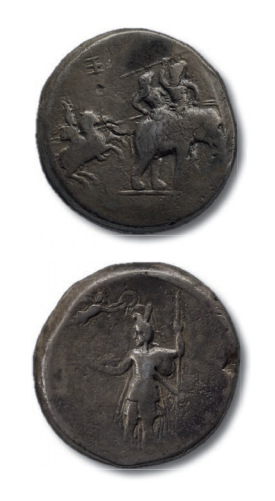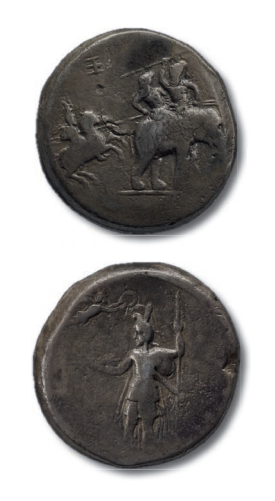INSIDER 29 | SPECIAL FEATURES | Some Talk of Alexander


By Jack West-Sherring
Alexander the Great’s victory over the Indian king Porus at the River Hydaspes (326 BC) was celebrated in commemorative Decadrachms known as ‘Porus medallions’. Discovered in Afghanistan in the late 19th century and bequeathed in 1926 to the British Museum, the example known as the ‘Frank medallion’ (see below) features on its obverse a Macedonian cavalryman locked in mortal combat with two Indian warriors astride a large elephant. The right-hand Indian’s feet are shown dangling below the elephant’s belly, implying his great height: this figure can only be Porus himself, for Ancient sources recorded Porus to have been “about six and a half feet tall” (Plutarch, Alex. 60.93). Porus’ Macedonian opponent appears diminutive in comparison yet is undoubtedly Alexander, his Phrygian helmet sporting the two white plumes defined by Plutarch as Alexander’s insignia (Alex. 16.7).
This image of Alexander is quite different from portraits depicted on the Tetradrachms of his Successors, of which there were two fi ne examples in Spink’s 25-26 September 2017 sale (lots 9 & 32). The Porus medallions, struck in Babylon c. 324 BC, offer us a lifetime portrait of Alexander and a glimpse of how Alexander himself wished to be portrayed.
In Curtius 8.14.46, Alexander is quoted as claiming “that his own greatness could be…increased proportionately by the greatness of the peoples he defeated.” The obverse of the Porus medallion reflects Alexander’s claim, the disparity between Porus’ imposing size and Alexander’s smallness drawing attention to Alexander’s valour in taking on such a formidable foe. This combat between Porus and Alexander never actually happened; Alexander was aware of cavalry’s limitations against elephants, which frightened horses. Alexander defeated Porus at the River Hydaspes by ordering his skirmishers to “release a thick barrage against the elephants and riders” (Curtius 8.14.25) before “the Macedonian phalanx responded with their own attack on the elephants, spearing their riders and, with a ring of men around them, inflicting multiple wounds on the animals” (Arrian 5.17.3). Such systematic execution is a far cry from Alexander’s heroic appearance on the Porus medallion, charging towards uncertain danger on a rearing horse, his cloak billowing in the wind. Coinage was Alexander’s means of rewriting history; with the Porus medallion, tales of his brave exploits could be spread throughout conquered lands, instilling fear and inspiring obedience.
The reverse of the Porus medallion propounds the message that Alexander’s victory at the Hydaspes resulted from divine intervention. Alexander is depicted with Zeus’ thunderbolts in his right hand: an allusion to the heavy rainstorms which concealed Alexander’s troop movements from Porus’ scouts, allowing him to cross the Hydaspes River undetected and gain the element of surprise (Arrian 5.12.3). Zeus, already considered Alexander’s father, did not desert his son at the hour of need. To the Ancient mind, this was proof enough of Alexander’s divinity. The Porus medallion testifies Alexander’s desire to be celebrated as a Homeric hero, blessed by the gods and ‘talked of’ for eternity at the same level as Hercules, Hector and Lysander.



